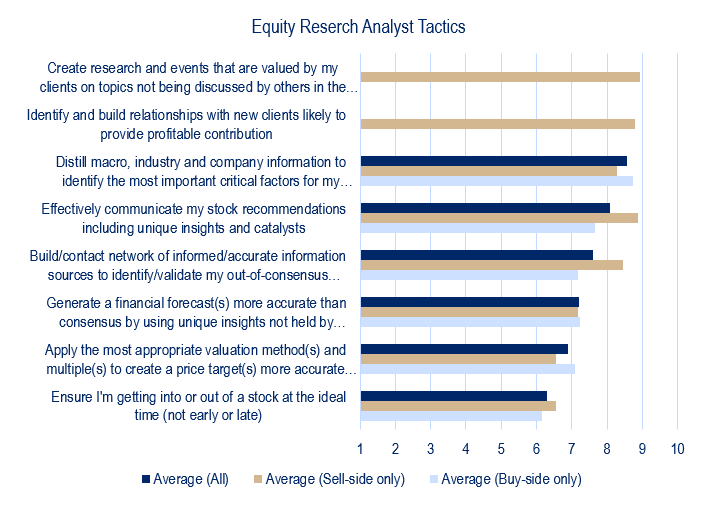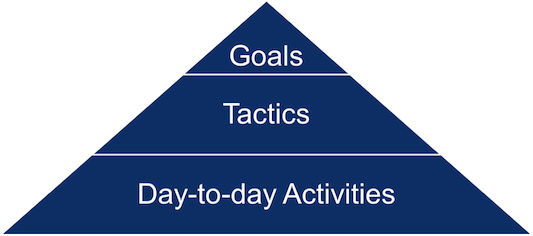The 6-8 Tactics for Being a Successful Equity Research Analyst

At the end of a typical work day, do you feel as though you achieved most of what you set out to do that morning? Are you regularly being acknowledged, or even rewarded, for doing a great job? If you answered “yes” to these questions, read no further.
But if you’re like the majority of equity research analysts I meet, they’re spending 50-70 hours at work each week, yet are not seeing an improvement in their stock picking performance or, for the sell-side, are not gaining more client votes.
One of the quickest ways to resolve this common challenge is to follow these 3 steps:
- Step 1: Set two professional goals
- Step 2: Utilize 6-8 tactics to achieve those goals
- Step 3: Once a week, review one week back and one forward to see if your day-to-day activities are perfectly aligned with steps #1 and #2 above
The best paid analysts ensure all of their day-to-day activities are supporting these 6-8 tactics
Let me take you through an example of how these three steps almost always guarantee success. Let’s first start with Step #1 above. Having coached hundreds of equity research analysts on time management, I’ve concluded there are only two primary goals:
- Generate alpha (for your firm or clients)
- Get recognition for your stock insights or picks (from your boss or clients)
Now that we have Step 1 out of the way, moving onto Step 2 – there are 6 to 8 tactics for achieving these goals:
- Distill macro, industry and company information to identify the most important critical factors for your assigned stocks (see this post for the “how to”)
- Build/contact network of informed/accurate information sources to identify/validate your out-of-consensus views for your critical factors (see this post for the “how to”). It’s worth mentioning that calling a company’s IR contact or simply accepting management’s guidance does not fulfill this tactic.
- Generate a financial forecast(s) more accurate than consensus by using unique insights not held by consensus
- Apply the most appropriate valuation method(s) and multiple(s) to create a price target(s) more accurate than consensus (see this post for the “how to”)
- Ensure you’re getting into or out of a stock at the ideal time (not early or late)
- Effectively communicate your stock recommendations, including unique insights and catalysts
Sell-side analysts have these two additional tactics:
- Create research and events valued by clients on topics not being discussed by others in the financial market or media
- Identify and build relationships with new clients likely to provide profitable contribution
The chart below contains the responses from 50 buy-side and sell-side analysts I surveyed on this topic, ranking the eight tactics’ importance in helping the analysts achieve their goals. The results are sorted from “most important” to “least important” based on their responses. It’s interesting to see the highest-rated tactics are from the sell-side for supporting their client facing goals:

I share these results:
- To show not all tactics are considered equally important
- To question aloud, could part of the mass exodus from actively-managed funds be due in part to analysts placing a relatively low priority on tactics that pertain to stock picking (the three lowest-ranked tactics above)?
Getting back to the original goal of this post, the toughest part of making the most of your professional time is ensuring all of your day-to-day activities support the 6-8 tactics above, and in the right weighting.
I’ll use the Jenga game to illustrate this point, which starts with 3 blocks on 18 levels, for a total of 54 blocks. Imagine each block represents 10 minutes of your day (equivalent to a 9 hour work day). How many would you remove for activities that don’t directly support the 6-8 tactics above? (And for this illustration, we’re not going to stack the extra blocks back on the tower…consider them time lost forever.) Would your tower look solid? Like Swiss cheese? Or worse yet, fall over? Be careful not to mischaracterize more of your time as “supporting a tactic” than is realistic. As I discuss in this post, a good portion of reviewing emails, voicemails or news that’s widely disseminated doesn’t truly support the tactics above.
If you think there’s room for improvement (I find over 90% of analysts I coach want help in this area), go to Step 3, by setting aside 15 minutes every week to have a meeting with yourself. Ensure it’s at a quiet, uninterrupted time when you have access to your calendar and to-do list (e.g. Saturday morning, Friday afternoon, Sunday evening). At each meeting, look at your calendar and ask yourself these questions:
- What did I do this past week that supported the 6-8 tactics above?
- Are my activities ensuring all of my key tactics are being supported?
- What do I have scheduled on my calendar for the next week that will support my key tactics above?
The best analysts fill their days with the right balance of activities that ultimately support all of their tactics, which in turn allows them achieve their goals. They are all aligned like the pyramid below. This post may help if you’re looking for steps to get more efficient with your time.

If you want to make improvements in this area, I challenge you to immediately open your calendar (before finishing this post) and create a recurring event for your 15-minute meeting going forward (mine is at 9 am every Saturday). If, after four weeks, you don’t see a major improvement, let me know because you’ll be the first analyst I know where following these steps didn’t have a meaningful impact.
This Best Practice Bulletin™ targets #6. Productivity of GAMMA PI™, within our Pathway to Success Framework
Let me know if this Best Practice Bulletin™ helps and how I can improve upon this best practice. If you’re interested in exploring this topic further, AnalystSolutions provides equity research training with a specialized workshop to help Maximize Your Time for Alpha Generation.
Improve you or your team’s stock picking and communication skills with our equity research analyst training tools, which includes workshops such as the one above, as well as our GAMMA PI™ assessment and one-on-one coaching. Also, consider ordering the book that inspired the founding of AnalystSolutions and the Best Practices Bulletin: Best Practices for Equity Research Analysts.
Visit our new Resource Center to find more helpful articles, reference cards, and advice towards your growth as an Equity Research Analyst.
©AnalystSolutions LLP All rights reserved. James J. Valentine, CFA is author of Best Practices for Equity Research Analysts, founder of AnalystSolutions and was a top-ranked equity research analyst for ten consecutive years
